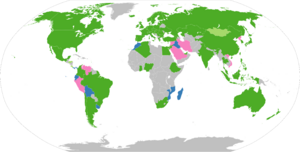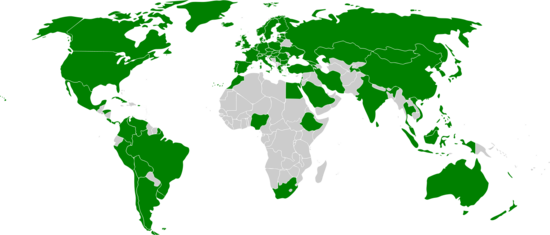International Astronomical Union facts for kids
|
Union astronomique internationale (UAI)
|
|
 |
|

National members from 85 countries as of May 2023
Member states States with interim status Observer states Suspended states
|
|
| Abbreviation | IAU/UAI |
|---|---|
| Formation | 28 July 1919 |
| Founded at | Brussels, Belgium |
| Type | INGO |
| Headquarters | Paris, France |
|
Region served
|
Worldwide |
|
Membership
|
85 national members 13,119 individual members |
|
General Secretary
|
|
The International Astronomical Union (IAU) is a worldwide group that helps advance astronomy. It works to promote research, education, and development in space science through teamwork across the globe. The IAU was started on July 28, 1919, in Brussels, Belgium. Its main office is now in Paris, France.
The IAU has two types of members. There are individual members, who are professional astronomers and young scientists. There are also national members, which are groups like science societies or universities from different countries. As of May 2024, the IAU had 85 national members and over 12,700 individual members from 90 countries.
One of the IAU's most important jobs is to host science meetings. It supports nine special meetings each year. It also holds a big meeting called the General Assembly every three years. This meeting helps set rules and includes many scientific discussions. The IAU is famous for being the main group that officially names astronomical objects. It also creates clear rules for how we define things in astronomy. The IAU also works with other global groups, like UNESCO, to achieve its goals.
Contents
What the IAU Does
The International Astronomical Union is a global group for professional astronomers. These are people with advanced degrees who do research and teach about space. One of its key roles is to officially name celestial bodies like stars, planets, and asteroids. It also names features on their surfaces.
The IAU is part of the International Science Council. Its main goal is to support and protect the science of astronomy. It does this by encouraging countries to work together. The IAU also works with groups that include amateur astronomers. The IAU's main office is located in the Institut d'Astrophysique de Paris.
This organization has many special groups that focus on different tasks. For example, the Working Group for Planetary System Nomenclature (WGPSN) names planets and their features. The Working Group on Star Names (WGSN) lists and standardizes star names. The IAU also manages astronomical telegrams. These messages share important news about new discoveries in space. The Minor Planet Center also works under the IAU. It keeps track of all small bodies in our Solar System that are not planets or moons.
History of the IAU
The IAU was founded on July 28, 1919. This happened at a meeting in Brussels, Belgium. At this meeting, two smaller groups were also created. These were the International Time Commission and the International Central Bureau of Astronomical Telegrams.
The first seven countries to join were Belgium, Canada, France, Great Britain, Greece, Japan, and the United States. Soon after, Italy and Mexico also joined. The first big meeting of the IAU was held in Rome, Italy, in May 1922. By the end of this meeting, 10 more countries had joined. This brought the total number of member countries to 19. Even though the IAU started after World War I, astronomers had been working together internationally for a long time before that.
The IAU has held special contests to name exoplanets. These contests were called NameExoWorlds. The first ones were in 2015 and 2019. The IAU is also working with the United Nations. They are helping to create rules for using resources on the Moon.
How the IAU is Organized
As of August 1, 2019, the IAU has over 13,700 individual members. These are professional astronomers from 102 countries. About 18% of these individual members are female.
The IAU also has 82 national members. These are professional astronomy groups that represent their country's connection to the IAU. Examples include the Australian Academy of Science and the Royal Astronomical Society in the United Kingdom.
The main decision-making body of the IAU is its General Assembly. All members are part of this Assembly. The Assembly decides on the IAU's rules and elects different committees.
When it's time to vote, the rules depend on what is being discussed.
- For science-related topics, only individual members can vote.
- For other matters, like changing the rules, only representatives from national members can vote.
For money matters, votes from national members are weighted. This means some countries' votes count more based on how much they contribute. To make a decision on these matters, at least two-thirds of the national members must be present. Most decisions need a simple majority to pass. However, changing the main rules needs a two-thirds majority. If there's a tie, the President of the Union makes the final decision.
Countries that are National Members
Africa
Asia
 Armenia
Armenia China
China Cyprus
Cyprus Georgia (suspended)
Georgia (suspended) India
India Indonesia
Indonesia Iran (suspended)
Iran (suspended) Israel
Israel Japan
Japan Jordan
Jordan Kazakhstan
Kazakhstan Lebanon (suspended)
Lebanon (suspended) Malaysia
Malaysia Mongolia
Mongolia North Korea (suspended)
North Korea (suspended) Philippines
Philippines Saudi Arabia (suspended)
Saudi Arabia (suspended) South Korea
South Korea Syria
Syria Taiwan
Taiwan Tajikistan
Tajikistan Thailand
Thailand Turkey
Turkey United Arab Emirates
United Arab Emirates Vietnam (suspended)
Vietnam (suspended)
Europe
 Austria
Austria Belgium
Belgium Bulgaria
Bulgaria Croatia
Croatia Czech Republic
Czech Republic Denmark
Denmark Estonia
Estonia Finland
Finland France
France Germany
Germany Greece
Greece Hungary
Hungary Iceland
Iceland Ireland
Ireland Italy
Italy Latvia
Latvia Lithuania
Lithuania Netherlands
Netherlands Norway
Norway Poland
Poland Portugal
Portugal Romania
Romania Russia
Russia Serbia
Serbia Slovakia
Slovakia Slovenia
Slovenia Spain
Spain Sweden
Sweden Switzerland
Switzerland Ukraine
Ukraine United Kingdom
United Kingdom Vatican City
Vatican City
North America
 Canada
Canada Costa Rica (interim)
Costa Rica (interim) Honduras (interim)
Honduras (interim) Mexico
Mexico Panama (interim)
Panama (interim) United States
United States
Oceania
South America
Past National Members
General Assembly Meetings
The IAU General Assembly meets every three years. This has been the case since 1922. The only exception was between 1938 and 1948, because of World War II.
In September 1973, an extra General Assembly was held in Warsaw, Poland. This was to celebrate the 500th birthday of Nicolaus Copernicus. This special meeting happened soon after the regular 1973 meeting in Sydney.
| Meeting | Year | Venue |
|---|---|---|
| Ist IAU General Assembly (1st) | 1922 | Rome, Italy |
| IInd IAU General Assembly (2nd) | 1925 | Cambridge, England, United Kingdom |
| IIIrd IAU General Assembly (3rd) | 1928 | Leiden, Netherlands |
| IVth IAU General Assembly (4th) | 1932 | Cambridge, Massachusetts, United States |
| Vth IAU General Assembly (5th) | 1935 | Paris, France |
| VIth IAU General Assembly (6th) | 1938 | Stockholm, Sweden |
| VIIth IAU General Assembly (7th) | 1948 | Zürich, Switzerland |
| VIIIth IAU General Assembly (8th) | 1952 | Rome, Italy |
| IXth IAU General Assembly (9th) | 1955 | Dublin, Ireland |
| Xth IAU General Assembly (10th) | 1958 | Moscow, Soviet Union |
| XIth IAU General Assembly (11th) | 1961 | Berkeley, California, United States |
| XIIth IAU General Assembly (12th) | 1964 | Hamburg, West Germany |
| XIIIth IAU General Assembly (13th) | 1967 | Prague, Czechoslovakia |
| XIVth IAU General Assembly (14th) | 1970 | Brighton, England, United Kingdom |
| XVth IAU General Assembly (15th) | 1973 | Sydney, Australia |
| XVIth IAU General Assembly (16th) | 1976 | Grenoble, France |
| XVIIth IAU General Assembly (17th) | 1979 | Montreal, Quebec, Canada |
| XVIIIth IAU General Assembly (18th) | 1982 | Patras, Greece |
| XIXth IAU General Assembly (19th) | 1985 | New Delhi, India |
| XXth IAU General Assembly (20th) | 1988 | Baltimore, Maryland, United States |
| XXIst IAU General Assembly (21st) | 1991 | Buenos Aires, Argentina |
| XXIInd IAU General Assembly (22nd) | 1994 | The Hague, Netherlands |
| XXIIIrd IAU General Assembly (23rd) | 1997 | Kyoto, Japan |
| XXIVth IAU General Assembly (24th) | 2000 | Manchester, England, United Kingdom |
| XXVth IAU General Assembly (25th) | 2003 | Sydney, Australia |
| XXVIth IAU General Assembly (26th) | 2006 | Prague, Czech Republic |
| XXVIIth IAU General Assembly (27th) | 2009 | Rio de Janeiro, Brazil |
| XXVIIIth IAU General Assembly (28th) | 2012 | Beijing, China |
| XXIXth IAU General Assembly (29th) | 2015 | Honolulu, Hawaii, United States |
| XXXth IAU General Assembly (30th) | 2018 | Vienna, Austria |
| XXXIst IAU General Assembly (31st) | 2022 | Busan, South Korea |
| XXXIInd IAU General Assembly (32nd) | 2024 | Cape Town, South Africa |
| XXXIIIrd IAU General Assembly (33rd) | 2027 | Rome, Italy |
| XXXIVth IAU General Assembly (34th) | 2030 | Santiago, Chile |
Leaders of the IAU
Here is a list of the past and current presidents of the IAU:
|
|
|
Teaching Astronomy
Commission 46 is a special committee of the IAU. It works to discuss astronomy development with governments and science groups. The IAU is connected to the International Council of Scientific Unions (ICSU). This group encourages countries to join the IAU.
Commission 46 also aims to improve astronomy education. One of its programs is called Teaching Astronomy for Development (TAD). This program helps countries where there is not much astronomy education. Another program is the Galileo Teacher Training Program (GTTP). This project focuses on teaching activities for children and schools. It helps share astronomy education tools and resources for science classes.
See also
 In Spanish: Unión Astronómica Internacional para niños
In Spanish: Unión Astronómica Internacional para niños
- List of astronomy acronyms
- Astronomical naming conventions
- List of proper names of stars
- Planetary nomenclature


